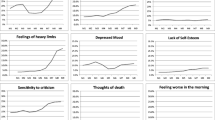Abstract
It was recently reported that pregnant women were more likely to have minor depression as measured by the Patient Health Questionnaire-8 depression scale (PHQ-8), (as reported by Kroenke and Spitzer (Psychiatr Ann 32(9):1–7, 2002), and Kroenke et al. (J Affect 114(1–3):163–173, 2009)) compared to women who were not pregnant (as reported by Ashley et al. (Arch Womens Ment Health 19(2):395–400, 2015)). The present study is designed to investigate if somatic symptoms (energy level, appetite, sleep) associated with both pregnancy and depression were responsible for this increased prevalence of minor depression. A sample of pregnant women (n = 404) was compared to women who were not pregnant (n = 6754). Both groups scored within the minor depression range on the PHQ-8 and comparisons were based on participants’ responses to PHQ-8 items. Results indicate that of the somatic symptoms of depression, only changes in energy level accounted for the elevated prevalence of minor depression among pregnant women compared to women who are not pregnant. Removing the decreased energy item from the score determination reduces the prevalence of minor depression among pregnant women to a level significantly below that of women who are not pregnant. Emotional symptoms such as feeling down and feeling like a failure were less likely to be reported by pregnant women compared to women who were not pregnant. Implications for depression screening during pregnancy are discussed.
Similar content being viewed by others
References
American Psychiatric Association (Ed.) (2000) Diagnostic and statistical manual of mental disorders: DSM-IV-TR (4th ed., text revision). Washington, DC: American Psychiatric Association.
American Psychiatric Association (Ed.) (2013). Diagnostic and statistical manual of mental disorders: DSM-5 (5th ed). Washington, D.C: American Psychiatric Association.
Ashley JM, Harper BD, Arms-Chavez CJ, LoBello SG (2015) Estimated prevalence of antenatal depression in the US population. Archives of Women’s Mental Health 19(2):395–400. doi:10.1007/s00737-015-0593-1
Centers for Disease Control and Prevention. (undated). Overview: BRFSS (2006a) U.S. Department of Health and Human Services, Centers for Disease Control and Prevention. Retrieved from http://www.cdc.gov/brfss/annual_data/2006/pdf/overview_06.pdf
Centers for Disease Control and Prevention (2006b) Behavioral Risk Factor Surveillance System Survey Data. Atlanta, Georgia: U.S. Department of Health and Human Services, Centers for Disease Control and Prevention. Retrieved from http://www.cdc.gov/brfss/annual_data/2006/files/CDBRFS06ASC.ZIP
Centers for Disease Control and Prevention (2007) Behavioral Risk Factor Surveillance System 2006 Codebook Report. Atlanta, Georgia: U.S. Department of Health and Human Services, Centers for Disease Control and Prevention. Retrieved from http://www.cdc.gov/brfss/annual_data/2006/pdf/codebook_06.pdf
Dhingra SS, Kroenke K, Zack MM, Strine TW, Balluz LS (2011) PHQ-8 days: a measurement option for DSM-5 major depressive disorder (MDD) severity. Popul Health Metrics 9:11. doi:10.1186/1478-7954-9-11
Fan AZ, Strine TW, Huang Y, Murray MR, Musingo S, Jiles R, Mokdad AH (2009) Self-rated depression and physician-diagnosed depression and anxiety in Florida adults: Behavioral Risk Factor Surveillance System, 2006. Prev Chronic Dis 6(1):A10
Gavin NI, Gaynes BN, Lohr KN, Meltzer-Brody S, Gartlehner G, Swinson T (2005) Perinatal depression: a systematic review of prevalence and incidence. Obstet Gynecol 106(5 Pt 1):1071–1083. doi:10.1097/01.AOG.0000183597.31630.db
Gaynes, B. N., Gavin, N., Meltzer-Brody, S., Lohr, K. N., Swinson, T., Gartlehner, G., … Miller, W. C. (2005) Perinatal depression: prevalence, screening accuracy, and screening outcomes. Evidence Report/Technology Assessment (Summary), (119), 1–8
Grote NK, Bridge JA, Gavin AR, Melville JL, Iyengar S, Katon WJ (2010) A meta-analysis of depression during pregnancy and the risk of preterm birth, low birth weight, and intrauterine growth restriction. Arch Gen Psychiatry 67(10):1012. doi:10.1001/archgenpsychiatry.2010.111
Kessler RC (2003) Epidemiology of women and depression. J Affect Disord 74(1):5–13
Klein MH, Essex MJ (1994) Pregnant or depressed? The effect of overlap between symptoms of depression and somatic complaints of pregnancy on rates of major depression in the second trimester. Depression 2(6):308–314. doi:10.1002/depr.3050020606
Kroenke K, Spitzer RL (2002) The PHQ-9: a new depression diagnostic and severity measure. Psychiatr Ann 32(9):1–7
Kroenke K, Strine TW, Spitzer RL, Williams JBW, Berry JT, Mokdad AH (2009) The PHQ-8 as a measure of current depression in the general population. J Affect Disord 114(1–3):163–173. doi:10.1016/j.jad.2008.06.026
Leung, B.M.Y. & Kaplan, B.J. (2009). Perinatal depression: prevalence, risks, and the nutrition link: A review of the literature. Journal of the American Dietetic Association, 109(9), 1566-1575. doi:10.1016/j.jada.2009.06.368
Marchesi C, Bertoni S, Maggini C (2009) Major and minor depression in pregnancy. Obstet Gynecol 113(6):1292–1298. doi:10.1097/AOG.0b013e3181a45e90
Matthey S, Ross-Hamid C (2011) The validity of DSM symptoms for depression and anxiety disorders during pregnancy. J Affect Disord 133(3):546–552. doi:10.1016/j.jad.2011.05.004
Smith MV, Gotman N, Lin H, Yonkers KA (2010) Do the PHQ-8 and the PHQ-2 accurately screen for depressive disorders in a sample of pregnant women? Gen Hosp Psychiatry 32(5):544–548. doi:10.1016/j.genhosppsych.2010.04.011
Striegel-Moore RH, Goldman SL, Garvin V, Rodin J (1996) A prospective study of somatic and emotional symptoms of pregnancy. Psychol Women Q 20(3):393–408. doi:10.1111/j.1471-6402.1996.tb00307.x
Author information
Authors and Affiliations
Corresponding author
Ethics declarations
This study was approved by the Institutional Review Board at Auburn University at Montgomery. All participants were drawn from the 2006 Behavioral Risk Factor Surveillance System (BRFSS), a random digit dialing telephone survey conducted annually by the Centers for Disease Control and Prevention (Centers for Disease Control and Prevention, undated).
Conflict of interest
The authors declare that they have no conflict of interest.
Rights and permissions
About this article
Cite this article
McMahon, A.B., Arms-Chavez, C.J., Harper, B.D. et al. PHQ-8 minor depression among pregnant women: association with somatic symptoms of depression. Arch Womens Ment Health 20, 405–409 (2017). https://doi.org/10.1007/s00737-017-0715-z
Received:
Accepted:
Published:
Issue Date:
DOI: https://doi.org/10.1007/s00737-017-0715-z




